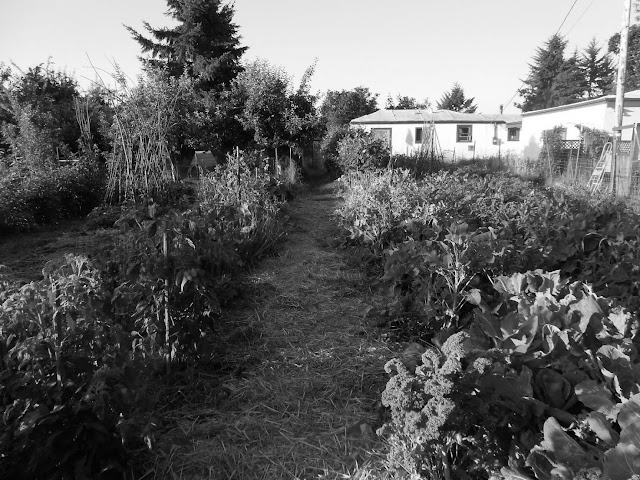As we worked on the playhouse in 1994, near the fence, a neighbor strode purposefully over. I chirped, "Hi! The kids had a playhouse like this at our last place, so we're building a replacement."
"Oh, okay." He pushed his ball cap, with its tractor-supply embroidery, back from his forehead. "I was gonna tell ya th' county don't allow building within ten feet of the th' line."
I had suspected as much, but seeing as we already had a building that close, namely the large stamping shed up in the corner, built in the 1960s, I had hoped the new little shed would not be an issue.
It must not have been, at least as a playhouse, because we never met the man again, other than to wave at him as he roamed around beneath his oak trees on his riding lawnmower.

In 2009, an empty nester and retiree, I looked over the little building, to which I'd paid little interest over the years, and thought it might be a suitable place to read and write. I brought yet more materials -- old carpets for insulation, old fence boards for the interior walls -- and reroofed the building.
For reading, I put in rustic shelves and a comfy chair.

For writing, a small desk and office chair. There was an old metal folding cot that had been my dad's, which I covered with a bit of foam and a blanket. In warm weather I could take breaks by napping on the cot.
The hut was off grid at first, being well away from the house, but
laptop batteries and thermal mugs offer a few hour's independence. As
winter came, I ran power to the hut and added a low-wattage space
heater.

Eight by ten, insulated, with a low ceiling, warms quickly even in winter, and I was able to leave the thermostat on a very low setting, or even turn off the heater and dress in layers.
Once you have power, though, one thing will lead to another. In 2014 it occurred to me to add a rudimentary kitchen.

The centerpiece was a thrift-store steamer that was missing its oblong plastic basket liner. I found that it could make assorted meals perfectly well in a bowl placed in the basket.
One fills the water reservoir, places the bowl under cover (not shown), and sets the timer. In five minutes it made ramen, in twenty it made rice, and even announced lunch with a pleasant "ding" as the mechanical timer wound down.
You might think the only thing missing was a bathroom. I had run a garden hose out to the hut and brought a couple of steel bowls from the house, with towels and the like, for various purposes. As for other business, I could run to the house, but friends had given us a composting potty, and I elected to park it in the barn, halfway between the hut and the garden and so convenient to both.
It was now possible to be independent from the house for days at a time.
Not that there was anything wrong with running to the homestead, and as a rule I hung out more there than at the hut. It has been a fine place to hang out.
The idea I was forming in my mind, though, was to try to spend part of every day, or of every available day, in a concentrated space, with relatively few things and distractions. Would it be possible, in short, at least on Thursdays, to emulate one of my childhood heroes?
I went to the woods because I wished to live deliberately, to front only
the essential facts of life, and see if I could not learn what it had
to teach, and not, when I came to die, discover that I had not lived. I
did not wish to live what was not life, living is so dear; nor did I
wish to practise resignation, unless it was quite necessary. I wanted to
live deep and suck out all the marrow of life, to live so sturdily and
Spartan-like as to put to rout all that was not life, to cut a broad
swath and shave close, to drive life into a corner, and reduce it to its
lowest terms ... --Thoreau, Walden


No comments:
Post a Comment
Stony Run Farm: Life on One Acre